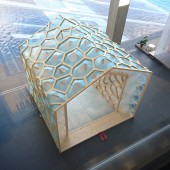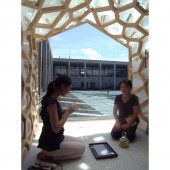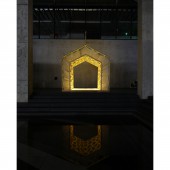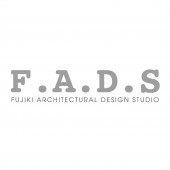Porous Manifold Japanese Tearoom by Ryumei Fujiki and Yukiko Sato |
Home > Winners > #72501 |
 |
|
||||
| DESIGN DETAILS | |||||
| DESIGN NAME: Porous Manifold PRIMARY FUNCTION: Japanese Tearoom INSPIRATION: Inspired by Hojoki ("An Account of My Hut"), written in the Middle Ages, to survive in our troubled times, about thirty groups of architects and artists selected through the open call (Jury: Hiroshi Hara, Ryue Nishizawa, Fram Kitagawa) exhibited their "hojo" (ten foot square hut) which represented their worldviews. In this exhibition, architects were especially asked to respond to the theme of how to overcome the concept of homogeneous space which was dominant in the 20th century. UNIQUE PROPERTIES / PROJECT DESCRIPTION: This is a temporary Japanese tearoom and a nested structure with two-tatami space embedded in ten foot square. In this exhibition, architects were asked to respond to the theme of how to overcome the concept of homogeneous space which was dominant in the 20th century. It is distorted homogeneous space to create irregularities by the random pattern of the skeleton and proposed an art-tecture with many holes which are open and close as necessary to communicate with the outside like living things. OPERATION / FLOW / INTERACTION: As you enter inside, this art-tecture (architecture) feels you and begins to breathe like a living thing. Specifically to say, many holes called BREATHING PLEATS start opening and closing according to the movement of people. PROJECT DURATION AND LOCATION: This work was exhibited in "Hojoki Shiki in 2018: The Universe of Ten Foot Square Huts by Architects and Artists" as a special exhibition during from July 29th to September 17th in Echigo-tsumari Art Triennale 2018, Niigata Pref. in Japan. In the present day, the global Financial capitalism has an impact on all regions, which have been required to accept the improved efficiency, rationalization and homogenization. This exhibition was an opportunity for the architects and artists to present their own Hojoki Shiki, proposing different "hojo", the minimum model of Japanese architecture. FITS BEST INTO CATEGORY: Fine Arts and Art Installation Design |
PRODUCTION / REALIZATION TECHNOLOGY: It is made of a hybrid of spruce CLT panels and plastic materials processed using digital fabrication technology. SPECIFICATIONS / TECHNICAL PROPERTIES: Width, Depth and Height are 2730mm each. This dimension was called a "Jo" in the old words in Japan. TAGS: Porous Manifold, Breathing Pleats, Voronoi Division, Japanese Tearoom RESEARCH ABSTRACT: Towards the generation of "heterogeneous space", we studied from a point of geometrical viewpoint. Homogeneous space is geometrically equivalent to 3D Euclidean space. The biggest problem of homogeneous space is that our imagination is captured by it, but in order to overcome this, it is necessary to extend the concept of homogeneous space rather than deny it. Just as Einstein discovered, it is important to introduce a structure that "space is distorted". It is distorted homogeneous space to create irregularities using random patterns found in various shapes and phenomena in nature (VORONOI DIVISION). CHALLENGE: Modern office buildings made in the 20th century are separated from the external environment by a closed curtain wall. Then, using the lighting and air conditioning equipment, it is idea to control so that all places are homogenous and constant environment artificially. However, we need enormous energy, which is a major factor of global environmental problems. It is important not to block the external environment and the internal space, but to open and close as necessary, that is, to create a building responsive to the external environment. Then it was created a living-like architecture. ADDED DATE: 2018-11-12 09:20:20 TEAM MEMBERS (8) : ARCHITECT: Ryumei Fujiki, Yukiko Sato, DESIGN FIRM: F.A.D.S + Fujiki Studio, KOU::ARC, TEAM MEMBERS: Yu Ohno, Seiya Ueki, Kento Watanabe, Yuta Kimura and Shun Takimoto IMAGE CREDITS: Masahiro Hoshida, Fujiki Studio, KOU::ARC PATENTS/COPYRIGHTS: F.A.D.S + Fujiki Studio, KOU::ARC |
||||
| Visit the following page to learn more: http://www.fads-design.jp | |||||
| AWARD DETAILS | |
 |
Porous Manifold Japanese Tearoom by Ryumei Fujiki and Yukiko Sato is Winner in Fine Arts and Art Installation Design Category, 2018 - 2019.· Read the interview with designer Ryumei Fujiki and Yukiko Sato for design Porous Manifold here.· Press Members: Login or Register to request an exclusive interview with Ryumei Fujiki and Yukiko Sato. · Click here to register inorder to view the profile and other works by Ryumei Fujiki and Yukiko Sato. |
| SOCIAL |
| + Add to Likes / Favorites | Send to My Email | Comment | Testimonials | View Press-Release | Press Kit | Translations |
Did you like Ryumei Fujiki and Yukiko Sato's Fine Art Design?
You will most likely enjoy other award winning fine art design as well.
Click here to view more Award Winning Fine Art Design.








